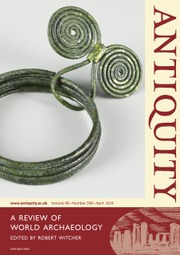
Archaeology, as Anna Källén, professor at Umeå University in Sweden, states in The trouble with ancient DNA, is “to a great extent a storytelling practice” (p.28), with carefully crafted tales used to enliven our understanding of past lives. The ways in which the results of ancient DNA (aDNA) studies are used to develop these stories is a perennial topic of debate in the field. Källén’s engaging new book adds nuance to this discourse by providing a critical assessment of the so-called ‘ancient DNA revolution’ on its own terms.
Källén’s novella-length book contains five readable and well-thought-out chapters, predominately focused on human aDNA research. Chapter 1, provides background information for the non-specialist reader, in a clear-eyed discussion of what DNA can and cannot tell us about our past; and it would provide an engaging primer to the field for an archaeology or genetics undergraduate student. The next three chapters expand Källén’s thesis through a discussion of high-profile aDNA studies. It is argued that, given the totemic nature of DNA in the public imagination, the results of these studies do not live in splendid academic isolation but affect how the past is perceived by society at large. Källén persuasively reasons that this complexity requires those who engage in aDNA storytelling to consider the political ramifications of their work and to clearly document its limitations. The final chapter provides a defence of the DNA molecule and a guide addressing some of the perceived shortcomings outlined in the preceding chapters.
Chapters 3 and 4 are the strongest in the book and live up to Källén’s aim not to “issue weary warnings” (p.31) but to advocate the “need to sit with, and dig deeper into, interdisciplinary conflict, rather than attempt to disguise or overrule it” (p.32). Chapter 3 begins with a discussion of how aDNA studies—for good or ill—now form part of a larger ‘ancestry economy’ that crucially includes the rise of commercial genetic ancestry testing services widely used by the general public. Källén carefully outlines the limits of resolution provided by genetic data to tell these complex tales of ancestry and advocates for greater transparency in the presentation of results. This call to arms is one that will likely resonate with many readers, particularly members of the cross-disciplinary early career research communities that have recently developed in the field of archaeogenetics (e.g. HAAM Community Reference Community2025). In Chapter 4, Källén provides case studies of how past lives can become “props” (p.107) in modern-day ethical and cultural debates. This chapter also tackles the thorny issue of how the results of an aDNA analysis—more often than not carefully caveated in research papers—can sometimes be presented to the general public via the media (willingly or unwillingly) as a fait accompli, with little scope for the discussion of competing narratives.
Källén’s book can be seen as a counterbalance to recent publications—such as David Reich’s popular science book Who we are and how we got here (Reference Reich2018), which is frequently mentioned in the text—that have provided a geneticist’s view of how aDNA can be used to understand the past. Källén is, however, careful to avoid the criticism that archaeologists are inherently distrustful of genomics, favouring a view citing Donna Haraway (Reference Haraway1988) that scientific results should be presented as “situated knowledge” (p.29) and that understanding uncertainty is a vital tool when disentangling the past from the present.
Throughout the text, I was struck by how many of the criticisms attributed to aDNA and genomic science could also be applied to other technologies that are used routinely in archaeology. For example, Källén’s discussions of the simplification of complex methods by the media (“It is literally depicted as if the results come straight out of the white powder”, p.95) and the need for careful interpretation of probabilistic results, could also easily be applied to Radiocarbon dating. The intellectual framework provided by Källén for thinking about aDNA results, therefore, may find a more general utility in the wider debate of how we integrate the results of technical advances into archaeological storytelling.
From an archaeologist’s perspective this book may be preaching to the converted, somewhat, in that most of the criticisms of aDNA research presented are already routinely discussed within the field. However, Källén’s in-depth methodological explanations and explicit examination of the real-world political consequences inherent in aDNA research are welcome additions to the debate—in particular, the considered discussion of who bears the ethical responsibility to set the record straight if the results of an aDNA study are distorted. While geneticists undertaking aDNA research may bristle at some of the descriptions of the field and possibly disagree with some of the conclusions presented in the text, those who engage with the overarching themes presented by Källén will find a useful space for self-reflection.

